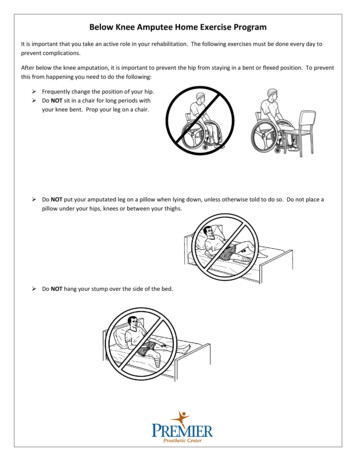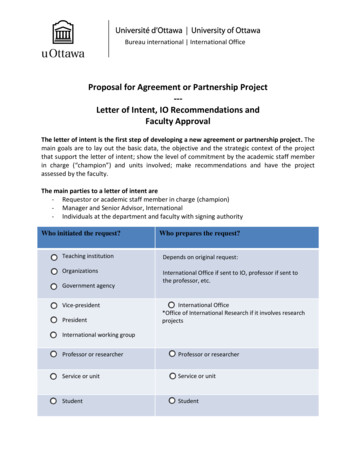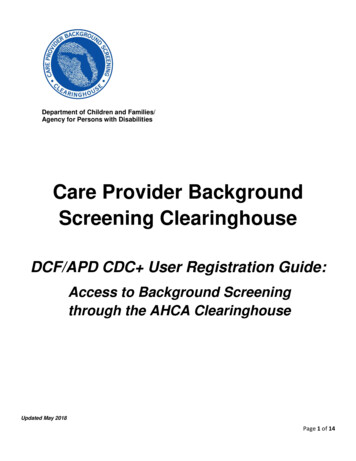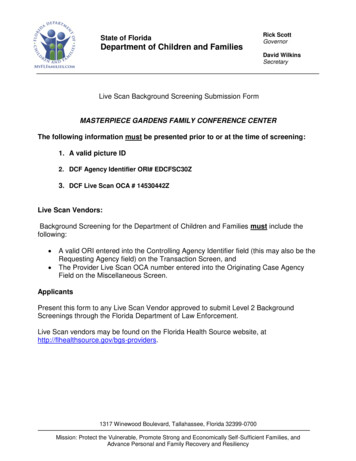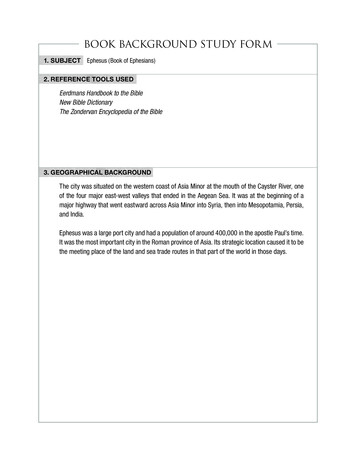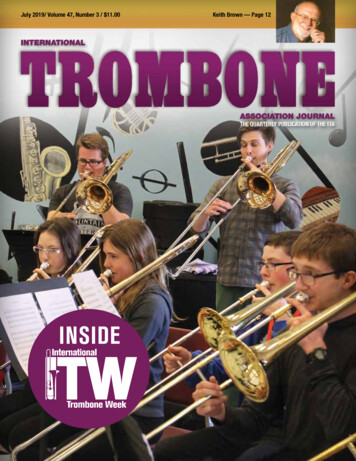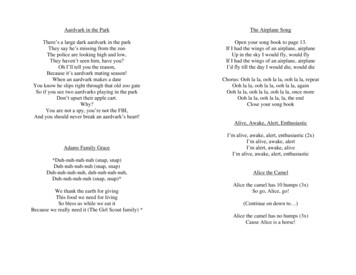
Transcription
BRING YOUR ASPIRATIONSPRESIDENT RITA HARTUNG CHENG SEPTEMBER 20, 2019
NAU'S STRATEGIC PLAN19551976ObjectivesPrimary FunctionsArizona StateCollege uralHeritageM AY 1, 19 6 6 – N O R T H E R N A R I Z O N A U N I V E R S I T YVocationalCompetenceUniversity Cabinet Individual Development Undergraduate andGraduate Education Critical Examinationof Ideas Excellence1997Institutional GoalsInstitutional Self-Study Report Premier ResidentialUniversity Partnerships withCommunity Colleges and K-12 Distance Learning Personal Philosophy Self-discipline Interrelationshipsof Disciplines Public Service Institution Understanding of theSocial and Natural Systems Apply Knowledge20162018Strategic Planning& Budget CouncilStrategic Planning & Budget CouncilStrategic GoalsStudent SuccessStrategic GoalsStudent Success and AccessGlobalEngagementGraduate Programsand ResearchGood CitizenshipOpportunities forNative earch and DiscoveryDiversity, CivicEngagement,and CommunityBuildingEngagementCommitment toNative AmericansCommitment toNative AmericansSustainabilityand EffectivenessStewardship
STRATEGIC PLAN 2018–2025MissionVisionOur academic programs, research, public service,and creative endeavors enrich lives and createopportunities in Arizona and beyond. We developsolutions to challenges and drive innovation in asupportive, inclusive, and diverse environment.NAU leads the way to a betterArizona and a sustainableworld through personalizedattention to student successand scholarly excellence.Core ValuesStudent-centeredWe place studentsuccess at the centerof our academic andservice planning,policies, and programs.ExcellenceWe committo the highestquality in allendeavors.DiversityWe strengthen ourcommunity throughdiversity of cultures,experiences, andperspectives.IntegrityWe operate withfairness, honesty,and the highestethical standards.DiscoveryWe engage in innovationto create, share, andapply new knowledge,scholarship, and artistry.ServiceWe partner with ourcommunities, in the spiritof collaboration, to provideservices and expertise tosupport Arizona, the nation,and the world.
ituVery high research: 131expend284MresCARNEGIE PYRAMIDHigh research: 135nrDoctoral research: 152diaMe4Mesearch46MsPBC Campuse CampusetatewidYuma and SMaster's collegesand universities: 685Baccalaurate colleges: 837Community colleges: 1,000Tribal andSpecialized: 1,384
PEER COMPARISONNAUABOR peermedian*Carnegie peermedian**ABOR2025 tal Fall 201731,05123,62216,66434,909Undergraduate % of Total Enrollment Fall 201787.2%81.2%80.9%86.8%% Diverse Enrollment Fall 201736.7%23.6%28%N/AFirst-year Retention Rates (Full-Time 2017)76%77.5%78%80%Six-year Graduation Rates (FY17)52%54%52.5%57.5%Undergraduate Degrees Awarded (FY17)6,0954,0482,7106,930Graduate Degrees Awarded (FY17)1,3661,4179961,180Research Expenditures (FY17) NSF HERD 46,253,000 54,754,000 62,471,000 46,800,000Public Service (FY17) IPEDS 32,567,000 20,694,000 15,015,814 35,500,000Enrollment categoriesUndergraduate Fall 2017Graduate Fall 2017Student success categoriesResearch and public service*ABOR Peers: Bowling Green State University – Main Campus, George Mason University, Georgia State University, Kent State University Kent Campus, Northern Illinois University, Ohio University –Main Campus, Old Dominion University, Southern Illinois University Carbondale, University of Akron Main Campus, University of Alabama in Huntsville, University of Maine, University of Nevada – Las Vegas,University of North Carolina at Greenboro, Western Michigan University, Wichita State University**Carnegie Classification High-Research Peers – Four-year public universities
NAU STATEWIDEA DISTINCTIVE MISSION TO SERVE ARIZONANS WHERE THEY LIVE AND WORKFort DefianceMohave Community CollegeFlagstaffNAU–Yavapai (2)Paradise Valley Community CollegeScottsdale Community CollegeNorthland Pioneer CollegeNAU–North ValleyGlendale Community CollegeNAU–East ValleyChandler-Gilbert Community CollegeEstrella Mountain Community CollegeEastern Arizona CollegePhoenix CollegePhoenix Biomedical CampusNAU–YumaCentral Arizona CollegePima Community College (2)South Mountain Community CollegeMesa Community College
NAU INNOVATION IN DISTRIBUTED LEARNINGDistributed learning comparison dataStudents enrolled exclusively in online educationcourses (FY17)NAUABOR peermedianCarnegie peermedian21%7%7% NAU distributed learning sitesRepresents more than 50% of ABOR system’s sites; growth at 9 locations Enhanced tribal college and university pathways Personalized LearningOnline Competency-Based program allows students to earn credits towards a degree basedon demonstrating mastery of skills. Students pay an all inclusive six-month subscription( 3,000 or 3,750 for Nursing) that covers as many courses as can be completed, allowingstudents to accelerate degree completion Increasing high-demand online degree offerings Targeted marketing initiative
ENROLLMENT TRENDAll Enrolled Headcount – 182019Community 12%13%14%14%16%18%19%19%18%18%Community 864,3384,3804,6595,0065,2585,0474,806Diverse PEDS/Hispanic TFT CohortFirst-gen ell emale Z Residency proportion67%68%67%65%66%62%60%64%64%65%67%66%65%
ENROLLMENT – UNDERGRADUATE DRIVENUndergraduate 0182019Community %86%87%87%87%87%86%FlagstaffOnlineYumaTotal% of Total Enrollment
ENROLLMENT TREND – COLLEGESAll Enrolled Student Trends by College, Fall 720182019Annual% Change’19 v. ’18Cumulative% Change’19 v. ’09College of Arts and 452,1472,2043%-16%College of ,4513,4023,296-3%-34%College of Engineering, Informatics, and Applied 0013,0412,814-7%85%College of Health and Human 8914,8404,8380%123%College of Social and Behavioral 5295,8256,2818%54%College of the Environment, Forestry, and Natural 971,4811,5223%41%Graduate College (non-degree)Online, Statewide, and Education Innovation*Provost 81,8401,537-16%16%The W. A. Franke College of 092010201120122013201420152016201720182019College of Arts and Letters11%11%10%10%9%8%7%7%7%7%7%TotalCollege of Education21%19%17%15%13%12%11%11%11%11%11%College of Engineering, Informatics, and Applied Sciences6%7%7%8%8%9%9%9%10%10%9%College of Health and Human Services9%9%10%11%13%14%14%15%16%16%16%College of Social and Behavioral Sciences17%18%18%18%18%17%17%17%18%19%20%College of the Environment, Forestry, and Natural Sciences12%13%14%14%15%15%15%15%15%16%16%Graduate College (non-degree)1%1%1%0%1%0%1%0%0%0%0%Online, Statewide, and Education Innovation*5%5%5%5%5%6%6%6%6%5%5%Provost Office6%6%7%7%7%8%7%7%6%6%5%The W. A. Franke College of 00%100%100%100%100%100%100%100%100%Total*Does not equate to NAU's total online enrollment; online enrollment may exist in any college.
ENROLLMENT – FALL 2019Graduate enrollment UP in all categories versus prior yearOnline, Community Campuses, Yuma, PBC, FlagstaffInternational enrollment DOWN versus prior yearGraduate and new undergraduate enrollment UPContinuing undergraduate enrollment DOWNUndergraduate enrollment DOWN versus prior yearNew first-year freshmen enrollment DOWNNew transfer enrollment DOWNUpper-division transfer UPLower-division transfer DOWNContinuing student enrollment DOWN
STRATEGIC ENROLLMENT MANAGEMENT PLANDEVELOPED THROUGH 2025 Engaged– EAB, Williams & Company, andstaff and faculty across the university Analyzed– Enrollment and demographic trendsnationally and regionally– Enrollment by student segment– Competitive landscape analysis– Program analysis Identified– Strategies, owners, timelines,targeted outcomes Results– Impact in spring 2019 tuition and feesetting process for FY19–20 throughtargeted program fee proposals– Retention improvement fall 2019
2025 PERFORMANCE METRICS2016–17Freshman Retention Rate2017–18 PreliminaryDegrees in High-Demand Fields30,3122018–19 Preliminary2019–20 Preliminary2025Undergraduate Enrollment4,5002017–182018–1980%77.6%Public Service Activity 35.5million3,86926,513*Graduate Enrollment4,597 34.9 million4,223*2025PERFORMANCEMETRICSInvention DisclosuresTransacted5050Research Activity 46.8 millionTotal Enrollment34,90930,736*55.6% 58 million57.5%6-year Graduation RateAZ CC Transfers AwardedBachelor’s Degrees2,5006,0852,083 49,3121,4406,930Bachelor’s DegreesAwardedEducation and RelatedExpenses per Degree 56,4901,810Graduate Degrees Awarded*All Enrolled
KEY RECENT SUCCESSES––––Student Successand AccessRetention improvement( 4.1% points)Graduate enrollmentincrease ( 5.7%)Statewide enrollmentincrease at 9 sitesNew internationalenrollment increase( 4%)Research andDiscovery– NSF HERDexpenditure increaseto 58M– 12M in F&Arevenue in FY19Engagement– InauguralNAU Giving DayMay 2019( 282,500)– Increased alumnichapter events/participation– Teachers AcademygraduatesStewardship /Financial– Reaffirmed bondrating July 2019– Days cash-on-handFY19 150 days– Net position growthin FY19
UNIVERSITY MARKETING:Building Differentiation in the Cluttered Higher Ed Market
DIFFERENTIATION IN THE BRAND “VALUE ityAwarenessUniversity Marketing: Building Differentiation in the Cluttered Higher Ed Market
HOW TO GET sity Marketing: Building Differentiation in the Cluttered Higher Ed Market
ATTRIBUTE RATINGS: CURRENT FLAGSTAFF UNDERGRADSUndergraduate Students20182015Opportunities for outdoor activitiesWide range of undergrad programsFaculty demonstrate a strong commitment to teachingFaculty are researchers/scholarsSurrounding community contributes to social experienceGood overall reputationDiverse student populationGood reputation in many areasHigh quality student servicesStudents become prepared to succeed in 21st-century careersAffordable 24.14.03.84.03.94.03.93.7Rigorous academic experience4.03.9Research plays vital role in students' intellectual developmentSmall class sizes3.93.73.83.7Source: How strongly do you agree or disagree that each of the following statements accurately describes the University? 5-POINT SCALEUniversity Marketing: Building Differentiation in the Cluttered Higher Ed Market
NAU RATINGS: FLAGSTAFF GRADUATE STUDENTSMost attribute ratings were statistically flat for this audience, and below the desired level (4.0), with a few exceptions.Graduate Students20182015Opportunities for outdoor activities4.44.3Wide range of undergrad programs--Faculty demonstrate a strong commitment to teaching4.34.1Faculty are researchers/scholars4.33.9Surrounding community contributes to social experience4.03.9Good overall reputation3.83.6Diverse student population3.83.6Good reputation in many areas3.93.7High quality student services3.83.8Students become prepared to succeed in 21st-century careers4.03.6Affordable education3.83.7Rigorous academic experience4.04.0Research plays vital role in students' intellectual development4.13.8Small class sizes3.83.7Wide range of graduate programs3.93.8Source: How strongly do you agree or disagree that each of the following statements accurately describes the University? 5-POINT SCALEUniversity Marketing: Building Differentiation in the Cluttered Higher Ed Market
NAU RATINGS: STATEWIDE UNDERGRADSRatings continued to be strong among current statewide campus studentsUndergraduate Students20182015Good overall reputation4.44.3Good reputation in many areas4.44.3Wide range of undergrad programs4.34.2Diverse student population4.34.0Faculty are researchers/scholars4.34.1Students become prepared to succeed in 21st-century careers4.34.2Affordable education4.34.3Faculty demonstrate a strong commitment to teaching4.24.4Small class sizes4.24.2Rigorous academic experience4.24.2Research plays vital role in students' intellectual development4.23.9High quality student services4.14.2Professors identify professional opportunities for their students4.03.6--Wide range of graduate programsSource: How strongly do you agree or disagree that each of the following statements accurately describes the University? 5-POINT SCALEUniversity Marketing: Building Differentiation in the Cluttered Higher Ed Market
NAU RATINGS: STATEWIDE CAMPUS GRADUATE STUDENTSRatings continued to be strong among current students at Statewide campuses and online.Graduate Students20182015Good overall reputation4.44.3Good reputation in many areas4.34.3--Diverse student population4.04.1Faculty are researchers/scholars4.34.2Students become prepared to succeed in 21st-century careers4.24.3Affordable education4.24.5Faculty demonstrate a strong commitment to teaching4.44.4Small class sizes4.24.2Rigorous academic experience4.34.4Research plays vital role in students' intellectual development4.03.9High quality student services3.84.3Professors identify professional opportunities for their students4.03.6Wide range of graduate programs4.24.4Wide range of undergrad programsUniversity Marketing: Building Differentiation in the Cluttered Higher Ed Market
KEY DIFFERENTIATOR: STUDENT-CENTRICITY0.15Rigorous academic experience0.1Good overall university reputationGood value for the moneyF2 (23.79 %)0.05Quality undergraduate programsFriendlyStudent-centeredStudents prepared to succeed in21 century careers0Good reputation within manyareas of studyPersonalFaculty demonstrate strongcommitment to teachingAffordable educationProfessors identify professionalopportunities for studentsFaculty are researchers/scholarsin their field-0.05Small class sizesGood fit for meFaculty are known for advising/mentoring studentsHigh-quality student services-0.1-0.15-0.2-0.15-0.1-0.050F1 (76.21 %)0.050.10.150.2University Marketing: Building Differentiation in the Cluttered Higher Ed Market0.25
ALUMNI CONFIRM THAT NAU DELIVERS ON “STUDENT CENTRICITY”11Gallup Alumni Survey, 2018University Marketing: Building Differentiation in the Cluttered Higher Ed Market
CAMPAIGN CRITERIA Embody key differentiators and extend to research and scholarship Personal “call to action” Anecdotes that connect to larger “brand culture” Learning experience that transcends how and where it is delivered Focus on high impact research achievements and innovations Able to accommodate ongoing storytellingUniversity Marketing: Building Differentiation in the Cluttered Higher Ed Market
BRAND CAMPAIGN TAGLINEUniversity Marketing: Building Differentiation in the Cluttered Higher Ed Market
The brand promise is that no matter who you are, where you’re from, and how you wantto learn, we will help you build the life you want to lead and the person you aspire to be.In essence, our offer is:[“bring your aspirations to NAU,and we’ll guide you along a journey thatwill make your aspirations come true”.]
FLESHING OUT THE BRAND POSITIONBrand PositionThemesDiscoverieshappen hereAbout yourself and theworld around you.Tailored tothe individualWho you are, who you wantto become, and how, where,and what you want to learn.Naturalenvironmentsfor learningWhere nature and thecommunities in which welive and learn becomeclassrooms.University Marketing: Building Differentiation in the Cluttered Higher Ed Market
FULLY LEVERAGING THE BRAND CAMPAIGNPositioning/messagingBrand CampaignActivationBrand campaignadvertisingOperationalizeAcross theInstitutionWebsitere-developmentUniversity Marketing: Building Differentiation in the Cluttered Higher Ed Market
CREATIVE STRATEGY: “THE VIRTUOUS TRIANGLE”University Marketing: Building Differentiation in the Cluttered Higher Ed Market
OUT OF HOME CREATIVE- STORYTELLINGUniversity Marketing: Building Differentiation in the Cluttered Higher Ed Market
OUT OF HOME CREATIVE: STATEWIDE AND ONLINE
MIGRATING THE CAMPAIGN TO THE WEB
INTERNAL BRANDING AND PROGRAM MARKETINGUniversity Marketing: Building Differentiation in the Cluttered Higher Ed Market
THE BRAND CAMPAIGN: STUDENT VOICES
ACADEMIC AFFAIRS NAU is adapting to change– New global economy– Changing national demographics– Academic restructuring and revisionsto process NAU is leveraging distinctivenessfor continued success– Commitment to quality teaching– Commitment to faculty engagement
ADAPTING TO CHANGE Academic Restructuring– Honors College– Online programs moved into Colleges– The College of the Environment, Forestry, andNatural Sciences and the College of Engineering,Informatics, and Applied Sciences– Enrollment Management and Student Affairs New Programs– High-demand degrees– Top growing programs Vision for the Future– Increased responsiveness and flexibility
BUILDING ON HISTORICAL STRENGTHSGROWTH AREASHEALTHEQUITY ANDHEALTHSCIENCEEARTH STRYWATERAND GYFOUNDATIONAL STRENGTHS
NAU INNOVATION IN DISTRIBUTED LEARNINGDistributed learning comparison dataNAUABOR peermedianStudents enrolled exclusively in online educationcourses (FY17)21%7%Carnegie peermedian7% NAU distributed learning sitesRepresents more than 50% of ABOR system’s sites; growth at 9 locations Enhanced tribal college and university pathways Personalized LearningOnline Competency-Based program allows students to earn credits towards a degree basedon demonstrating mastery of skills. Students pay an all-inclusive six-month subscription( 3,000 or 3,750 for Nursing) that covers as many courses as can be completed, allowingstudents to accelerate degree completion Increasing high-demand online degree offerings Targeted marketing initiative
NATIONAL RECOGNITION FOR QUALITY INSTRUCTION Frontier Set APLU cluster initiative Nationally-recognizedteaching experts
NAU PHD GRADUATES IN FACULTY POSITIONSUniversity of ArizonaUniversity of Illinois atUrbana-ChampaignCarnegie Mellon UniversityUniversity of Montana, MissoulaColorado State UniversityUniversity of Nevada, Las VegasEastern Michigan UniversityUniversity of Nevada, RenoGeorgetown UniversityUniversity of New HampshireGeorgia State UniversityUniversity of New MexicoIdaho State UniversityUniversity of South CarolinaIowa State UniversityUniversity of TennesseeKent State UniversityThe University of UtahMercer UniversityThe University of VermontMiami UniversityUniversity of WashingtonNew Mexico State UniversityUtah State UniversityUniversity of Central FloridaWestern Michigan UniversityUniversity of Hawaii
FACULTY ENGAGEMENT% Strongly AgreeNAU AlumniNational peersRegional competitorsI had at least one professor at NAU who made me excited about learning.71%59%58%My professors cared about me as a person.37%18%18%While attending NAU I had a mentor who encouraged me to pursue mygoals and dreams.*28%19%20%*Of those identifying a mentor, the mentor was a professor.81%60%58%Source: Gallup Alumni Survey, 2018
CULMINATING RESEARCH EXPERIENCESUndergraduate research participationUG Symposium Participationby Affiliation (N 837)CAL: 24CEFNS: 199SBS: 311CEIAS: 151HONORS: 42CIE: 9HHS: 39FYS: 5First Scholars: 15COE: 8FCB:FBC: 3333
STUDENT ACCESS/SUCCESSStudent Support EcosystemFirst-generationcollege toringand coachingStudent activitiesCourse redesignand outcomesDiversity andinclusionHigh achieversAcademic t AffairsExtra-curricularClubs,organizations,and Greek lifeDevelopmentalEducationCareer guidanceResidentialexperiencesHealth andwell-beingStudentleadership andengagementAdvocacy andstudentassistance
STUDENT ACCESS/SUCCESSStrategies to address the needs and barriers related to student success: Begin outreach before classes begin sostudents start with strong academic andsocial engagement Engage students in timely conversationswith advisors and student successprofessionals throughout the first year Identify each incoming student'snon-cognitive, motivational risks tocompletion and requests for assistance Initiate professional developmentconversations early by identifyingwhere students are in their careerplanning process Use data to match campus services to theneeds of specific populations Prioritize academic support service andstudent success interventions early in thefirst and second terms Develop first- and second-yearprogramming with a focus onstudent engagement
STUDENT mentsMidterm vitasPredictiveAnalyticsCulture of Care Allows us to addressissues as a preventativeapproach Cross-functional team Drives students toeffective interventions
STUDENT ACCESS/SUCCESSFirst-year Student Success Identify the key factors thatpredict freshman retention Compare the retention ofinitiative participants toretention of non-participants Control for the key factors toensure none are influencing theretention outcomes
STUDENT ACCESS/SUCCESSFall 2017 Program Retention ResultsParticipantBalanced sNAU 100:NAU 130:PeakUSC 150:Transition to Back on Track Performance Making sfulLearningTransition sNative Bridgeto SuccessPeer ar
STUDENT ACCESS/SUCCESSResults Drive Action Residential Learning Communities– Positive effects of RLCs drove scaling them to Residential Colleges; fromroughly 800 new freshmen each year to all new freshmen living on campus.– Course clustering and retention analysis led to pairing and clusteringfreshmen in the same sections to facilitate student connection, peer support,study groups, etc. Back on Track (course for academic probation freshmen)– Positive effects of the course led to a policy requiring it and creating aversion of the course for transfer students. Eliminated Initiatives– TEAM mentoring showed no effect on student retention and was eliminated.– An experiment was conducted matching Back on Track courses with peermentors with those without peer mentors and found no differential effect.Peer mentoring was subsequently eliminated from the course along withcourse fees saving students 90,000 in fees and freeing up 42,000 in statebudget for other initiatives.
EXPANDED MENTAL HEALTH CARE Hired four of the six new counselors(remaining two start within the month) Implementing a peer support program The integrated care model includesbehavioral health coordinators (studenthealth fee supported) to provide briefinterventions and assist with referrals tospecialty mental health providers Expanded prevention education includingKognito training for faculty Kognito training required for allhigh-touch peer-educator studentworkers within Student Affairs division—approximately 2,500 student employees Implemented the EverFi suite ofproducts including the mental healthmodule for students Expansion of alcohol/drug screening inhigh-traffic student programs and offices
STUDENT ACCESS/SUCCESSOne-year Retention Rate TrendFirst Time, Full-time 5% 4Fall Cohort2015201620172018
WHERE ARE WE RECRUITING?35 recruitersbased inArizona,California,Colorado,and TexasRecruiting Nationwide
ENROLLMENT MANAGEMENT36 StudentServiceCoordinatorssupportingonline andstatewiderecruitmentand enrollmentFort DefianceMohave Community CollegeFlagstaffNAU–Yavapai (2)Paradise Valley Community CollegeScottsdale Community CollegeNorthland Pioneer CollegeNAU–North ValleyGlendale Community CollegeNAU–East ValleyChandler-Gilbert Community CollegeEstrella Mountain Community CollegeEastern Arizona CollegePhoenix CollegePhoenix Biomedical CampusNAU–YumaCentral Arizona CollegePima Community College (2)South Mountain Community CollegeMesa Community CollegeMeeting Students Where They Are
ACCESS - DIVERSITYEnrollment – Closing the Achievement GapEnrollment Update/AZ ComparisonNAU – Fall 201960%55.1%AZ Census 2016 teHispanic/LatinoInt’l/Not Specified/Other*2%Two or More3.3%4%Black/AfricanAmerican2.9%4%American Indian/Alaska Native2.2%3%Asian0.3% 0.2%Native Hawaiian/Other Pacific Islander*Federal IPEDS categories
ACCESS - DIVERSITYPell GrantRecipientsEnrollment by Race and 19,06930,7363,9027,8622972,466Diversity nic/LatinoInternational/Not Specified/OtherTwo or MoreBlack/African AmericanAmerican Indian/Alaska NativeAsianNative Hawaiian/Other Pacific Islander*Federal IPEDS Categories2012**2019**Data compilation began in 2012
STUDENT ACCESSAverage Amount of Debt at Graduation, Students with Debt 45,000 40,000 36,935 38,042 38,105 38,994 22,518 23,022 38,314 37,414 22,817 22,797 38,308 35,000 30,000 25,000 22,673 20,000 15,000 22,929ASU: 21,592UA: 22,269 21,847ASU: 24,575UA: 24,968 10,000 te2014–152015–162016–172017–18Source: 2018 ABOR Financial Aid Report
STEWARDSHIP/FINANCE – CREDIT RATINGSMoody'sFiscal YearStandard & Poor's (S&P)RatingOutlookRatingOutlook2013A1StableA Stable2014A1StableA Stable2015A1StableA Stable2016A1StableA Stable2017A1StableA Stable2018A1StableA Stable2019A1StableA Stable Positive rating factors cited by agencies include NAU’s presence as a large,comprehensive university; multiple years of growth in wealth, liquidity, andenrollment; good operating reserves; and a healthy history of monthly dayscash-on-hand. Offsetting factors include strong enrollment competition, high maximumannual debt service compared to agency medians, and narrow reservesrelative to debt.
DAYS CASH-ON-HAND TREND2019Ratio 2018(prelim)A Cash/Investment ,788153,294193,647205,853221,357208,800B Expenditure ,289449,428470,878496,092503,368503,683C Multiplier365365365365365365365365365365365365 A/B*C120132210191167148131124150151161151 FY19 budget included cash payments for strategic capital projectsScience Annex and Recital Hall 2020 ABOR-approved liquidity range:112 to 186 Days ( /- 25% of Median 149 Days published by Moody's)
FINANCE / REVENUE 5FY2016FY2017FY2018FY2019FY2020budgetChangefrom ’08State General Fund (IncludingResearch 14,300(45,179)Tuition and 9Government Grants and Contractsand Federal Financial 688,91494,300101,400110,600116,00058,538Auxiliary 8,100590,300603,200629,600229,156Revenue % of 015FY2016FY2017FY2018FY2019FY2020budgetChangefrom ’08State General Fund (IncludingResearch
Enrollment categories NAU ABOR peer median* Carnegie peer median** ABOR 2025 goal Undergraduate Fall 2017 27,084 18,738 13,597 30,312 Graduate Fall 2017 3,967 4,712 3,308 4,597 Total Fall 2017 31,051 23,622 16,664 34,909 Undergraduate % of Total Enrollment Fall 2017 87.2% 81.2% 80.9% 86.8% % Diverse Enrollment Fall 2017 36.7% 23.6% 28% N/A Student success categories

